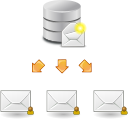Over the past few years, I’ve had the pleasure of using various different email marketing platforms.
I’ve been able to classify them into three groups:
MailChimp Review
Pay-per-Subscriber
MailChimp is arguably the most popular pay-per-subscriber email platform. It’s also the one I have the most experience with.
MailChimp Pros: It has a very intuitive visual email designer, which makes sense for marketers but is flexivlble enough for a web developer.
Caveats: It’s important to put thought into how you structure your subscriber list from the beginning.
You can only send a campaign to one subscriber list (if you want to send it to another list, you have to duplicate the campaign).
Also, you pay per “unique list subscriber”, not per unique account subscriber. What this means is that if you have the same subscriber on two different lists, that subscriber will count twice toward the total subscriber count.
The recommended workaround to this is to keep related subscribers in the same list, but break them down into “groups”. You can use these groups to create segmentation conditions that allow you to send a campaign to a select group of subscribers.
For developers, MailChimp has a fantastic API that is continually being improved. There are MailChimp API SDKs available in a few languages on GitHub.
The reporting is unmatched. With goal and e-commerce tracking, you can really gauge campaign effectiveness without ever stepping outside of MailChimp.
StreamSend Review
Pay-per-Email
StreamSend doesn’t necessarily lead in the pay-per-email space, but I have used them for years and have grown comfortable with their service.
StreamSend’s interface isn’t nearly as refined as MailChimp’s, though it does the job. Their HTML editor works, but doesn’t break your content down into “reusable blocks” like MailChimp does.
Overall, StreamSend is a great tool for email marketers that don’t require some of the more advanced features like split testing or goal tracking.
Semi-experienced users will find the price point appealing, the learning curve acceptable and that the reporting (combined with Google Analytics) has the requirements for a decent marketing campaign.
As the summary table at the bottom of this post illustrates, StreamSend is most cost-effective when sending emails on a monthly or bi-weekly basis.
MailChimp starts to make more sense, cost-wise, if you are emailing at least 3 times/month (either via regular campaigns or automation).
Sendy Review
Self-Hosted
I’m new to the self-hosted email marketing world, so I don’t exactly know where Sendy fits in. What I do know is that, combined with Amazon SES, you can save a good bundle of change by self-hosting your email.
Sendy is ridiculously simple to install. It runs on your standard PHP / MySQL stack. Best of all, the source code is unencrypted, so you’re able to make modifications wherever you like.
I would personally recommend that your database server be on localhost. I’ve been using Amazon RDS with my Sendy installation and noticed that it lags a bit. I can only assume that it requires too many round-trips from the database server for each page load.
Since Sendy uses Amazon SES to send the emails, you may find that your first blast takes a few hours to send. In my case, my emails-per-second allotment was restricted because I was new to Amazon SES. On the second blast, for some reason, my emails-per-second allotment was raised.
Those are really my only two complaints with Sendy at this point. The second one isn’t even on Sendy’s end.
You will find that Sendy lacks many of the advanced segmentation and automation features found in StreamSend or MailChimp, but the product is a work in progress. I wouldn’t be surprised to find those features slowly introduced in coming releases.
Other than that, I think it’s a fine product and well worth the $60 one-time price tag.
Summary
MailChimp is great if you email your subscribers more than once or twice a month, or if you have automation requirements.
StreamSend makes sense for companies that have a large number of subscribers, yet only email them on a monthly basis.
Sendy is great for anyone that is technically proficient or simply looking to save money. It’s also a pretty good fit for those who have a large number of subscribers and send less frequently than monthly.
By the Numbers
This table compares the three reviewed email marketing services against the monthly cost of emailing subscribers at different intervals. I pulled these values in May 2016 so they may, of course, change over time.
| Subscriber Count | Weekly Email (per month) |
Monthly Email (per month) |
Quarterly Email (per month) |
|---|---|---|---|
| 5,000 | $50 | $50 | $50 |
| 10,000 | $75 | $75 | $75 |
| 20,000 | $150 | $150 | $150 |
| 50,000 | $240 | $240 | $240 |
| 100,000 | $475 | $475 | $475 |
| Subscriber Count | Weekly Email (per month) |
Monthly Email (per month) |
Quarterly Email (avg. per month) |
|---|---|---|---|
| 5,000 | $60 | $35 | $25 |
| 10,000 | $100 | $40 | $40 |
| 20,000 | $160 | $60 | $60 |
| 50,000 | $280 | $100 | $100 |
| 100,000 | $560 | $160 | $160 |
| Subscriber Count | Weekly Email (per month) |
Monthly Email (per month) |
Quarterly Email (per month) |
|---|---|---|---|
| 5,000 | $2 | $0.5 | $0.16 |
| 10,000 | $4 | $1 | $0.33 |
| 20,000 | $8 | $2 | $0.67 |
| 50,000 | $20 | $5 | $1.67 |
| 100,000 | $40 | $10 | $3.30 |

